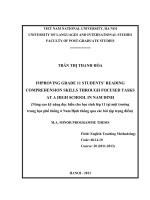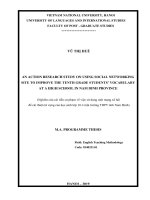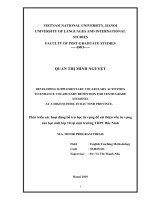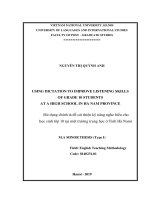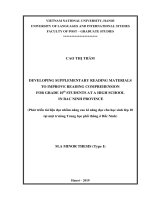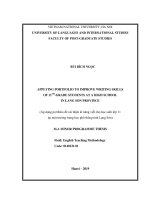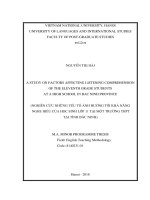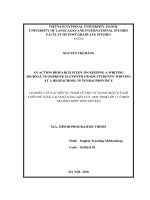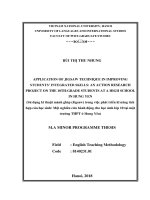Improving grade 10th students’ speaking proficiency at a high school in dien bien through using role play activities
Bạn đang xem bản rút gọn của tài liệu. Xem và tải ngay bản đầy đủ của tài liệu tại đây (2.23 MB, 101 trang )
VIETNAM NATIONAL UNIVERSITY, HANOI
UNIVERSITY OF LANGUAGES & INTERNATIONAL STUDIES
FACULTY OF POST – GRADUATE STUDIES
BÙI TRUNG NGA LINH
IMPROVING GRADE 10TH STUDENTS’ SPEAKING PROFICIENCY
AT A HIGH SCHOOL IN DIEN BIEN
THROUGH USING ROLE-PLAY ACTIVITIES
Cải thiện khả năng nói tiếng Anh của học sinh lớp 10 tại một trường
THPT ở Điện Biên qua sử dụng các hoạt động role-play
M.A. MINOR PROGRAMME THESIS
Field: English Teaching Methodology
Code: 8140231.01
Hanoi, June 2018
VIETNAM NATIONAL UNIVERSITY, HANOI
UNIVERSITY OF LANGUAGES & INTERNATIONAL STUDIES
FACULTY OF POST – GRADUATE STUDIES
BÙI TRUNG NGA LINH
IMPROVING GRADE 10TH STUDENTS’ SPEAKING PROFICIENCY
AT A HIGH SCHOOL IN DIEN BIEN
THROUGH USING ROLE-PLAY ACTIVITIES
Cải thiện khả năng nói tiếng Anh của học sinh lớp 10 tại một trường
THPT ở Điện Biên qua sử dụng các hoạt động role-play
M.A. MINOR PROGRAMME THESIS
Field: English Teaching Methodology
Code: 8140231.01
Supervisor: Prof. Dr. Hoàng Văn Vân
Hanoi, June 2018
DECLARATION
I, Bùi Trung Nga Linh, hereby certify that the thesis entitled “Improving grade 10th
Students‟ speaking proficiency at a high school in Dien Bien through role-play
activities” is the result of my own research, and that the thesis has not been
submitted for any degree at any other university or tertiary institution.
Hanoi, June 2018
Student‟s signature
Bùi Trung Nga Linh
ACKNOWLEDGEMENTS
During the process of writing this thesis, I have been fortunate to receive support
and assistance from a variety of people.
First and foremost, I would like to express my extreme gratitude to my supervisor,
Prof. Dr. Hoàng Văn Vân for his patient and enthusiastic guidance, encouragement,
invaluable assistance throughout my research.
I am also grateful to the lectures and all the staff members of the Faculty of PostGraduate Studies, ULIS, VNU for providing me valuable lessons, support and
encouragement in fulfillment of this thesis.
My thanks also go to the principal, teachers and the 10th graders at X high school
in Dien Bien for their cooperation and support for my data collection.
Finally, but most of all, my thanks to my beloved family who always supported
and encouraged me to overcome the difficulties during my study.
Hanoi, June 2018
Bùi Trung Nga Linh
i
ABSTRACT
This action research aimed at improving students‟ speaking proficiency by
implementing role-play technique. The research subjects were 32 grade 10th
students in class 10A1 at X high school in Dien Bien city in the first semester. The
role-play activities were organized in each speaking lesson from unit 1 to unit 8 of
the textbook “Tiếng Anh 10”. This research was carried out in two cycles including
4 steps: planning, doing action, observing and reflection. The qualitative data were
obtained by observing, semi-structured interviews, and questionnaires the grade 10
students in class 10A1. The instruments used to collect data were observation,
teaching diaries, interviews, and questionnaires. Pre-test and two post-tests were
administered to obtain the quantitive data which were in the forms of speaking
scores. The research findings showed that the use of role-play activities improved
students‟ speaking skills. The improvement could be seen from:
(1) Students‟ pronunciation, grammar, vocabulary, comprehension and fluency
(2) Students‟ confidence, enthusiasm, and opportunities to speak
(3) The mean score of pre-test (4.984), post-test 1 (6.437), and post-test 2
(7.703)
In conclusion, role-play was a trustworthy technique in promoting students‟
speaking competence.
ii
TABLE OF CONTENTS
DECLARATION
ACKNOWLEDGEMENTS ............................................................................................... i
ABSTRACT ....................................................................................................................... ii
TABLE OF CONTENTS ................................................................................................. iii
ABBREVIATION ............................................................................................................ vi
LIST OF TABLES ........................................................................................................... vi
LIST OF FIGURES ......................................................................................................... vi
PART A. INTRODUCTION ............................................................................................ 1
1. Rationale ......................................................................................................................... 1
2. Research objectives ......................................................................................................... 3
3. Research questions .......................................................................................................... 3
4. Scope of the study ........................................................................................................... 3
5. Design of the study.......................................................................................................... 3
PART B. DEVELOPMENT ............................................................................................. 5
CHAPTER I: LITERATURE REVIEW ........................................................................ 5
1. Speaking .......................................................................................................................... 5
1.1. Definition of speaking .................................................................................................. 5
1.2. Difficulties in speaking ................................................................................................ 5
1.3. Teaching Speaking ....................................................................................................... 8
1.3.1. Aspects of speaking................................................................................................... 8
1.3.2. Types of speaking activities .................................................................................... 10
1.3.3. The role of teachers in teaching speaking ............................................................... 14
1.3.4. Assessing speaking skills ........................................................................................ 16
2. Role-play ....................................................................................................................... 18
2.1. Definition of role-play................................................................................................ 18
2.2. Types of role-play ...................................................................................................... 19
2.3. Procedures for making successful role-play activities ............................................... 22
iii
3. Previous research on techniques/methods to improve students‟ speaking
proficiency in general and role-play in particular ............................................................. 26
3.1. Techniques/methods used to improve students‟ speaking skill in general ....................... 26
3.2. Prior studies on using role-play to enhance students‟ speaking proficiency in
particular............................................................................................................................ 27
4. Summary ....................................................................................................................... 29
CHAPTER II: METHODOLOGY................................................................................ 30
1. Research type ................................................................................................................ 30
2. The setting of the study ................................................................................................. 31
2.1. An overview of X high school ................................................................................... 31
2.2. The course outline of teaching and learning English ................................................. 31
3. Selection of the participants .......................................................................................... 33
4. Data collection methods ................................................................................................ 34
4.1. Class observation ....................................................................................................... 34
4.2. Testing students‟ performance ................................................................................... 34
4.3. Semi-structured interviews......................................................................................... 35
4.4. Questionnaires ............................................................................................................ 35
5. Data analysis ................................................................................................................. 35
6. Data collection procedure ............................................................................................. 36
6.1. Research cycle ............................................................................................................ 36
CHAPTER III: FINDINGS AND DISCUSSION ........................................................ 39
1. Research findings .......................................................................................................... 39
2. Discussion of the research findings .............................................................................. 44
PART C: CONCLUSION............................................................................................... 45
1. Conclusion..................................................................................................................... 45
2. Implications ................................................................................................................... 46
3. Suggestions ................................................................................................................... 46
3.1. For teachers ................................................................................................................ 46
3.2. For students ................................................................................................................ 47
iv
3.3. For further studies ...................................................................................................... 47
REFERENCES ................................................................................................................ 48
APPENDICES ................................................................................................................. 52
v
ABBREVIATION
ECAs:
Extracurricular activities
LIST OF TABLES
Table 1: Sample 1 of scoring rubric speaking................................................................... 16
Table 2: Sample 2 of scoring rubric speaking................................................................... 17
Table 3: Speaking activities and topics designed for class 10A1 ..................................... 32
Table 5: The mean score of the pre-test ............................................................................ 41
Table 6: The mean score of the pre-test ............................................................................ 41
Table 7: The mean score of the post-test 2 ....................................................................... 41
Table 8 : A summary about the improvement of students‟ speaking ability ........................... 43
LIST OF FIGURES
Figure 1: Action Research Process ................................................................................... 30
Figure 2: The procedure of the research ........................................................................... 38
Figure 3: The comparison of the mean score of each aspect among the tests ......................... 42
Figure 4: The comparison of the total mean scores of the students‟ speaking skills ........ 42
vi
PART A. INTRODUCTION
1. Rationale
English has been used more and more widely, and it is considered as one of the
most important languages in every part of the world. It plays an instrumental role in
all aspects such as education, travel and business, internet, and so on. It helps
people communicate with each other even they come from other countries.
Understanding the necessity of English in the development of society in the
integration and globalization in general and of each individual in particular, the
demand for learning English Vietnamese people gets stronger and stronger power.
That is the reason why the teaching and learning English has been paid more
attention recently in Vietnam, and it cannot be denied that English is now a
compulsory subject in language teaching programs at many schools and
universities.
In teaching language, there are four major language skills taught such as listening,
speaking, reading, writing. Of all the four skills, speaking seems intuitively the most
important: people who know a language are referred to as „speakers‟ of that
language, as if speaking included all other kinds of knowing (Ur, 1996, p.117). It
can be understood that when a man goods at speaking; he also goods at listening,
reading and writing. He will know how to use language actively to express and
convey the message to the listeners easily. Actually, the recent research also
demonstrated that speaking is an important factor which helps the learners form and
develop their language learning process such as developing listening skills (Regina,
1997), writing skills (Trachsel & Severino, 2004) and reading competence (Hilferty,
2005). Although it is considered as the central skill integrated with other skills, it is
also seen as one of the most difficult and challenging skills that the language
learners have to face. Thus, this is the reason why the students are not interested in
speaking lessons as well as find it very difficult to participate in speaking activities.
Based on my observation and teaching experience, there are some problems in
teaching – learning speaking. I can see that most my students are unwilling to
1
participate in all oral activities because of nervousness, lack of confidence or ideas.
They tend to sit passively, take notes, rarely contribute to any lessons, and even let
the teacher talk all the time. Another problem is, most the pairs get stuck when
teacher asks them to act out in front of the class. They do not know how to express
what they want to say in English, and they are afraid of making mistakes.
Furthermore, the results of each speaking examination are usually low, therefore, as
a teacher of English at a high school, I would like to find a certain suitable method
to help my students have ability to communicate confidently in English. During
attending four years at Hanoi National University of Education and from my own
experience, I realize that creating enjoyable and effective activities in the classroom
plays a vital role; moreover, the learners‟ language performance will be more
successful if they practice in real or realistic communicative task, so I think that
using role-play technique can be seen as a good way to motivate and give students
opportunities to enhance their speaking skills. As identified by Harmer (2001,
p.352), role-play can be used as the teaching tool to encourage students‟ oral
fluency or to train them to be aware to speak in specific situations by playing role to
be another person in that case. This leads the learners to practice directly and have
experiences in solving the problems in real world situation as natural as possible. In
line with Harmer, Ladousse (2009, p.5) also states that role-play is an enjoyable
activity and does not threaten the students. It brings up various experiences into
classroom such as broadening the knowledge about grammar, vocabulary and
creating more chances for the children to make the conversation, communication
games and humanistic exercises. In other words, the students can have more
opportunities to speak by doing these activities.
The above reasons have inspired me to conduct an action research to on
“Improving grade 10th Students‟ speaking proficiency at a high school in Dien Bien
through role-play activities”. I hope that the research will make a little contribution
to enhance the quality of teaching and learning speaking skills as well as teaching
and learning language for both teachers and students at this school.
2
2. Research objectives
This action research is conducted in order to:
Seek how “role-play” activities improve English speaking skills and
develop communicative skills for the grade 10th students at a high school
in Dien Bien.
3. Research questions
In order to achieve the objectives mentioned above, the study is designed to
answer the following research question:
“How does role-play help grade 10 students at a high school in Dien Bien
overcome their difficulties in speaking lessons?”
4. Scope of the study
This study is only a small-sized scale study and it is conducted to find out the
students‟ difficulties in learning speaking English as well as examine how role-play
activities help them improve their speaking ability. Thus, there is only one grade 10
class at a high school in Dien Bien is selected for study.
5. Design of the study
The study is organized into three main parts: Introduction, Development and
Conclusion.
Part A, Introduction, introduces the importance of learning English,
especially learning speaking English; presents the rationale, the objectives
when applying the role-play activities to improve speaking skills for the
students who have never been acquainted with this technique before.
Part B, Development, is divided into three chapters:
Chapter I defines some key terms related to this topic with a critical
literature review of previous related studies.
Chapter II illustrates the research methodology with the elaboration on
the participants, data collection and analysis instruments as well as
research procedure.
Chapter III analyzes and discusses the results found from the data to get
3
the answer to the research questions.
Part C is the conclusion of the study which summarizes and synthesizes the
main issues discussed in the thesis, points out some implications of the
research and recommends some suggestions for teachers, students and
further studies.
4
PART B. DEVELOPMENT
CHAPTER I: LITERATURE REVIEW
1. Speaking
1.1. Definition of speaking
There are some definitions about speaking that have been proposed by different
experts in language learning. As asserted by Brown and Yule (1983, p. 55),
“speaking is to express the needs – request, information, service, etc.”. It means that
the speaker says words to the listener not only to express what he/she needs but also
to obtain information or services. In order to strengthen the statement, McDonough
and Shaw (2012, p. 157) add this is a procedure that creates utterances with the
particular purposes when people communicate with each other, and this process
may involve expressing ideas and opinions. Based on these two definitions, it can
be understood in a simple way that speaking is a process of communication between
the sender and the receiver to exchange information, ideas, opinions, views, or
feelings.
Besides, Chaney and Burk (1998, p. 13) have another definition of speaking basing
on linguistics. They state that speaking is “the process of building and sharing
meaning through the use of verbal and non-verbal symbols, in a variety of contexts”
while Nunan (2003, p.48) defines that “Speaking is the productive aural/oral skill
and it consists of producing systematic verbal utterances to convey meaning”. These
researchers‟ opinions have some differences but they share one perception; that is,
speaking is identified as a process a person uses the language to express his or her
ideas, feelings and thoughts and shares information to other through
communication.
From these above definitions, speaking skill is always related to communication. It
can be stated that speaking can be seen as a skill which uses language accurately to
express meanings, and to get knowledge and information from other people in the
whole life situation.
1.2. Difficulties in speaking
5
Of the four language skills, speaking remains the most difficult skill to master for
the majority of English learners, and they are still incompetent in communicating
orally in English. As highlighted by Afisa and Yolanda (2015, p. 9), there are four
difficulties in speaking faced by students such as student‟s lack of vocabulary, poor
pronunciation, poor arrangement of words and anxiety. Learners‟ lack of
vocabulary is the result from their limited knowledge of meaning and small
vocabulary; this leads to difficulties in understanding the conversation. Therefore, it
is necessary to provide the students with the suitable amount of vocabulary to help
them study speaking easily. The next difficulty the students experience is poor
pronunciation of words. This is because many English words may be pronounced in
one way but may be written in another. For example, the students tend to confuse
and feel difficult in pronouncing when some words end with the /s/ sound but it is
pronounced as /z/ sound. The students are also confused in arranging words in
correct order. Then, there are still some mistakes in their grammar. The last
difficulty mentioned in Afisa and Yolanda‟ dissertation is the students‟ anxiety.
They are often afraid in speaking English because they are worried of making
mistakes. In addition, they are unconfident and nervous when the teacher asks them.
The difficulties in learning speaking English come from various reasons.
According to Ur (1996, p. 117), there are four factors that cause difficulty in
speaking such as inhibition, nothing to say, low or uneven participation and mother
tongue. In producing English speech, students are worried about making mistakes,
fearful of criticism, or simply shy. Sometimes, they have no motive to express their
thinking, feelings by themselves. If speaking is a compulsion, there is are few
learners who can talk while the others choose to be silent during the lesson. Mothertongue use is the last factor causes speaking difficulties to the learners. Students
tend to use the mother tongue with their friends because it is easier to interact.
Sometimes, the difficulties also come up from the learners, teaching strategies,
curriculum, and environment (Raba‟ah, 2005, p.193- 194). Brown (2001, p. 270271), in contrast, claims other eight factors that cause to speaking difficulty to
6
students which can be represented as follows:
Clustering
Redundancy
Reduced forms
Performances variables
Colloquial language
Rate of delivery
Stress, rhythm, and intonation
Interaction
According to Brown (Ibid.), clustering refers to fluent in speech. This is one of the
aspects make speaking more complicated because a fluent speech is a phrasal not
word by word. The second factor is redundancy. It tells about the speakers‟ ability
in providing the clearer meaning, but most students do not know how to make short
meaningful utterances. Next, reduced forms are the common troubles the learners
get in learning process. They usually use during native speakers‟ conversations. In
order to improve speaking skills as well as communicate naturally like native
English speakers, it is quite challenging for the non-native English speakers. Here is
an example for illustrating this factor: I want to go for a spin. = I wanna go for a
spin. In this example, it can be seen clearly that the item “wanna” is reduced from
the phrase “want to”, and it makes the speaking become better. The fourth factor is
performance variables which refer to the students‟ performance of hesitations,
pauses, backtracking and correction, such as the use of “fillers” like “uh, hm, as we
know, and so on. Commonly, the learners tend to answer the teachers‟ questions
directly in a shortest way without thinking and do not know how to continue this
topic to make it better. For instance, when the teacher asks “Do you like playing
football?”, instead of answering more information about it, the learners just say
“Yes” and finish their conversation immediately. The next aspect is colloquial
construction. It refers to the students‟ use of informal language ability in ordinary or
familiar conversation. The quality of speaking will be decreased if the learners
7
apply rigorous formal sentences in all conversations. The other factor mentioned by
Brown is rate of delivery. The rate refers to the speed at which a person speaks:
quickly or slowly. Speedier talkers prevent listeners from absorbing the ideas while
slow talkers make the receiver feel uncomfortable. Stress, rhythm and intonation are
the aspects that cause difficulties to the students‟ learning speaking. Different from
other languages, English has its own stress, rhythm and intonation. Those aspects
belong to the pronunciation stress and are executed in order to convey meaning,
message and feelings by changing the tone. Obviously, if keeping in the same tone,
speakers cannot convey what they want and what they say means. The last factor is
interaction which needs the creativity of conversational negotiation.
1.3. Teaching Speaking
Speaking is one of the central elements of communication which enables students
to use their English to communicate in real life situation; therefore, speaking is
often seen as the most important aspect that attracts attention from many researchers
and teachers. Nunan (2003), in reporting a study conducted by Kayi (2012),
expresses “what the teaching speaking to teach ESL students means”. According to
him, teaching speaking is teach to the students produce the English speech sounds
and sound patterns; use word and sentence stress, intonation patterns and the rhythm
of the second language; select appropriate words and sentences according to the
proper social setting, audience, situation and subject matter; organize the students‟
thoughts in a meaningful and logical sequence; use language as a means of
expressing values and judgments; and use the language quickly and confidently
with few unnatural pauses, which is called as fluency. In order to reach these above
objectives, it is important that teachers should care about the elements of an
effective communication such as aspects of teaching, activities to promote students‟
speaking, the teachers‟ role in teaching speaking and the way to assess students‟
speaking skills. These components will be discussed in detail as follows.
1.3.1. Aspects of speaking
Aspects of speaking can also be divided as many ways. According to Hughes
8
(2003, p.118), there are five components of speaking, namely pronunciation,
grammar, vocabulary, fluency and comprehension. Pronunciation refers to the way
a word is pronounced. To make the communication become better, it is necessary
that students know how to pronounce the words clearly so that the others can
understand the meaning of messages. Grammar is another important component of
speaking. Using the correct grammar structure will help people know the real
meaning of the sentences that the speakers would like to convey. The third aspect is
vocabulary. This can be seen as the most important element in speaking English or
other languages because it will show a person‟s speaking ability by using various
suitable vocabulary in conversation. Next, speaking is a process of exchanging ideas
between speaker and listener; therefore, a smooth and accurate speaking will make
human easy to understand the meaning. Comprehension is the last aspect the
students should master in communication. In order to make effective
communication, both speaker and listener have to understand other‟s meaning.
Similar to Hughes‟s viewpoint, Roger et al. (2005, p. 99-100) and Richards (2015,
p.426-427) summarize speaking aspects into two main types: accuracy and fluency.
They define accuracy as follows:
“Accuracy involves the correct use of vocabulary, grammar and pronunciation.
In controlled and guided activities, the focus is usually on accuracy and the
teacher makes it clear from feedback that accuracy is important. Ongoing
correction is often appropriate during accuracy activities. In freer activities the
teacher is hoping for the correct use of language but is also keen to encourage
the students‟ attempts to use the language they have in order to communicate. In
feedback the teacher will probably comment on correct use of language but also
on how successfully the students communicated”. (Roger et al. 2005, p. 99).
“Accuracy can refer to a number of different of a person‟s spoken English. It
conventionally refers to features of grammar, pronunciation and word choice,
but, as we have seen from the discussion above, there are many other aspects of
spoken language that are involved in oral communication, including choosing
9
appropriate topics, using language that matches the formality or informality of
the occasion and using conventions associated with different genres – such as
conventional ways of opening and closing small talk and conversations”.
(Richards, 2015, p. 427).
And they define fluency as follows:
“Fluency can be thought of as „the ability to keep going when speaking
spontaneously‟. When speaking fluently students should be able to get the
message across with whatever resources and abilities they‟ve got, regardless of
grammatical and other mistakes. Normally, students should not be corrected
during fluency activities. However, in feedback afterwards you can comment
favorably on any strategies the students used to increase their fluency.” (Roger
et al. 2005, p. 100).
“Fluency involves maintaining the flow of speech without disruptive pauses,
restarts and breakdowns. It usually develops when students have a good grasp
of grammar, vocabulary and fixed expressions, and can access them
automatically and can focus on the meanings they wish to express without being
distracted by a search for grammar or vocabulary or the correct expression”
(Richards, 2015, p. 426).
Based on these classification, it is considered that accuracy and fluency are the two
significant elements that the teachers should focus on in teaching speaking skills. In
my own situation, I realize that most students tend to have troubles in choosing
what words to say, confusing the verb tense when making the sentences as well as
lack of confidence in speaking. Therefore, it is necessary that as a teacher I should
be ready for finding and guiding the suitable ways to help them improve these
aspects.
1.3.2. Types of speaking activities
There are many activities to promote students‟ speaking ability suggested by
researchers which are represented as follows:
Drawing on several research of many scholars, Kayi (2012) presents the following
10
thirteen activities to promote students‟ speaking:
a. Discussion
After a content-based lesson, a discussion can be held for various reasons. The
students may aim to arrive at a conclusion, share ideas about an event, or find
solutions in their discussion groups. Before the discussion, it is essential that the
purpose of the discussion activity is set by the teacher. In this way, the
discussion points are relevant to this purpose, so that students do not spend their
time chatting with each other about irrelevant things.
b. Role-play
Students pretend they are in various social contexts and have a variety of social
roles. In role-play activities, the teacher gives information to the learners such as
who they are and what they think or feel. Thus, the teacher can tell the student that
"You are David, you go to the doctor and tell him what happened last night, and"
c. Simulations
Simulations are very similar to role-plays but what makes simulations different
than role-plays is that they are more elaborate. In simulations, students can bring
items to the class to create a realistic environment. For instance, if a student is
acting as a singer, she brings a microphone to sing and so on.
d. Information gap
In this activity, students are supposed to be working in pairs. One student will
have the information that other partner does not have and the partners will share
their information. Information gap activities serve many purposes such as
solving a problem or collecting information.
Also, each partner plays an
important role because the task cannot be completed if the partners do not
provide the information the others need.
e. Brain storming
On a given topic, students can produce ideas in a limited time. Depending on
the context, either individual or group brainstorming is effective and learners
generate ideas quickly and freely. The good characteristic of brainstorming is
11
that the students are not criticized for their ideas so students will be open to
sharing new ideas.
f. Storytelling
Students can briefly summarize a tale or story they heard from somebody
beforehand, or they may create their own stories to tell their classmates. Story
telling fosters creative thinking. It also helps students express ideas in the format
of beginning, development, and ending, including the characters and setting a
story has to have.
g. Interviews
Students can conduct interviews on selected topics with various people. It is a
good idea that the teacher provides a rubric to students so that they know what
type of questions they can ask or what path to follow, but students should
prepare their own interview questions. After interviews, each student can present
his or her study to the class. Moreover, students can interview each other and
"introduce" his or her partner to the class.
h. Story completion
For this activity, a teacher starts to tell a story, but after a few sentences he or
she stops narrating. Then, each student starts to narrate from the point where the
previous one stopped. Each student is supposed to add from four to ten
sentences. Students can add new characters, events, descriptions and so on.
i. Reporting
Before coming to class, students are asked to read a newspaper or magazine and,
in class, they report to their friends what they find as the most interesting news.
Students can also talk about whether they have experienced anything worth
telling their friends in their daily lives before class.
j. Playing cards
In this game, students should form groups of four. Each suit will represent a
topic. For instance:
Diamonds represent earning money
12
Hearts represent love and relationships
Spades represent an unforgettable memory
Card represents best teacher.
Each student in a group will choose a card. Then, each student will write 4-5
questions about that topic to ask the other people in the group. For example:
If the topic "diamonds: earning money" is selected, here are some possible
questions:
Is money important in your life? Why?
What is the easiest way of earning money?
What do you think about lottery? Etc.
However, the teacher should state at the very beginning of the activity that
students are not allowed to prepare yes-no questions, because by saying yes or
no students get little practice in spoken language production. Rather, students
ask open-ended questions to each other so that they reply in complete sentences.
k. Picture narrating
This activity is based on several sequential pictures. Students are asked to tell
the story taking place in the sequential pictures by paying attention to the criteria
provided by the teacher as a rubric. Rubrics can include the vocabulary or
structures they need to use while narrating.
l. Picture describing
For this activity students can form groups and each group is given a different
picture. Students discuss the picture with their groups, then a spokesperson for
each group describes the picture to the whole class. This activity fosters the
creativity and imagination of the learners as well as their public speaking skills.
m. Find the differences
For this activity students can work in pairs and each couple is given two
different pictures, for example, picture of boys playing football and another
picture of girls playing tennis. Students in pairs discuss the similarities and/or
differences in the pictures.
13
Beside these activities, Richards (2015, p. 433) adds more activities to promote
students‟ speaking skills, such as dialogue work with the aim at teaching fixed
expressions and routines; study transcriptions of spoken language which is used to
develop awareness of nature of authentic interactions, grammar, differences
between casual and formal interactions; surveys and questionnaires that are used to
develop communication strategies; ranking activities to express opinions and justify
choices; jigsaw activities are used to give accurate descriptions; repeating an
activity several times to develop fluency and use more complex language; record
the students‟ performance to identify errors and recognize need for more complex
language; and tasks should be used to present information clearly and practice
comprehension checks.
In short, there are a great variety of activities that can be used in a spoken English
class; however, it does not mean that the teacher has to apply all of these activities
in teaching speaking. They should consider and select the suitable techniques to
help their students be ready to engage in speaking lessons.
1.3.3. The role of teachers in teaching speaking
The role of teacher in the classroom can affect the success of teaching and learning
process. Teachers should play such of different roles in teaching speaking. As
collected from other researchers‟ study, Asfa (2010, p. 10-11) claims the teacher‟s
role can be seen as:
Prompter: It means that students sometimes get lost, cannot think what to
say next, or in some other way lose the fluency the teacher expects of them.
It is better if the teacher will help them leave to struggle out of situation by
offering discrete suggestion.
Participant: Teachers can be seen as a good model for the students
simulate. In some activities, the teachers may participate in discussion or
role-play themselves with their students to ensure the continuing of students‟
engagement and maintain creative atmosphere.
However, they do not
participate too much and give their students more opportunities to practice.
14
Feedback provider: When students are practicing or have finished the
speaking activity, the direct correction may cause inhibition and make them
unwilling to the next activities. On the other hand, helpful and gentle
correction may get students out of the mistakes or errors they have made.
Corresponding to these roles, Kayi (2012, p. 12) suggest some actions the teachers
should do while teaching oral language:
Provide maximum opportunity to students to speak the target language by
providing a rich environment that contains collaborative work, authentic
materials and tasks, and shared knowledge.
Try to involve each student in every speaking activity; for this aim, practice
different ways of student participation.
Reduce teacher speaking time in class while increasing student speaking
time. Step back and observe students.
Indicate positive signs when commenting on a student's response.
Ask eliciting questions such as "What do you mean? How did you reach that
conclusion?" in order to prompt students to speak more.
Provide written feedback like "Your presentation was really great. It was a
good job. I really appreciated your efforts in preparing the materials and
efficient use of your voice"
Do not correct students' pronunciation mistakes very often while they are
speaking. Correction should not distract student from his or her speech.
Involve speaking activities not only in class but also out of class; contact
parents and other people who can help.
Circulate around classroom to ensure that students are on the right track and
see whether they need your help while they work in groups or pairs.
Provide the vocabulary beforehand that students need in speaking activities.
Diagnose problems faced by students who have difficulty in expressing
themselves in the target language and provide more opportunities to practice
the spoken language.
15
In conclusion, teachers‟ role is a crucial part in teaching speaking classes, and it
can affect the success of teaching and learning process.
1.3.4. Assessing speaking skills
Assessment plays a vital role in the teaching speaking skills. It not only helps the
teachers identify whether their teaching methodology is suitable with the students
but also evaluates the students‟ performance in speaking. From that, the teacher can
find out the appropriate method to help their learners overcome the difficulties in
the learning process as well as let the students know what their strengths and
weaknesses are. The learners‟ oral ability can be assessed through oral examinations
such as interview, role-playing, acting out a conversation in pairs or groups,
discussing and solving a problem and so on. Obviously, the aspects of teaching
speaking will be tested basing on these oral testing tasks. Thus, it is extremely
necessary to the teacher to form a rating scale to score the learners‟ performance.
The following table will present a sample of scoring rubric speaking.
Table 1: Sample 1 of scoring rubric speaking
Categories
Fluency
Vocabulary
Pronunciation
Score
Guide
3
Has a generally smooth flow, with self-correction and
little hesitation.
2
Speaks slowly, using hesitant or halting speech.
1
Makes no attempt or shows constant hesitation.
3
Uses excellent vocabulary with relative ease.
Demonstrates an increasing knowledge of words and
expressions.
2
Uses vocabulary that is just adequate to respond. No
attempt is made to use a variety of expressions.
Generally understood, but limited to the very basic.
1
Makes no attempt, or response is totally irrelevant or
inappropriate.
3
Can be understood in the target language, but may make
few or minor errors. Makes an effort to sound “native,”
i.e., uses target language speech patterns, intonation, and
phrasing.
2
Can be understood in target language, but may make one
or two major errors and/or has some interference from
English language speech sounds, patterns, and rules.
16
